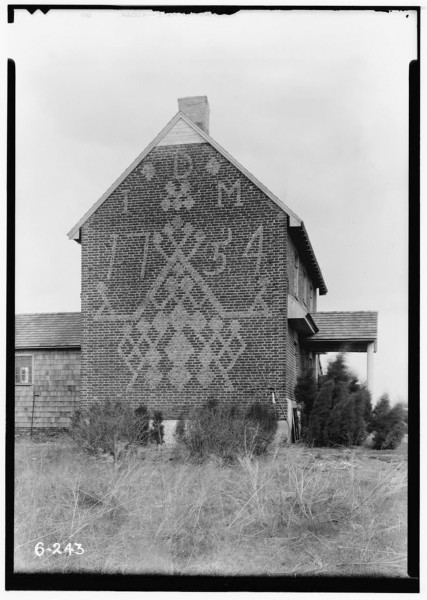Vermont’s Martin Chittenden House once had a twin, built several miles away along the river for Martin’s brother Noah Chittenden; it burned down in 1885. Both houses boasted “checkerboard brickwork” in their end walls, laid in patterned Flemish bond. Flemish checker is the most common form of patterned brickwork.
Extant examples of decorative, patterned brickwork occur between North Carolina and Connecticut—with a concentration of houses, built generally by Quakers between 1680 and 1830, in southwestern New Jersey. The National Register nomination for remaining houses called the brickwork “the first recognizable ‘architecture of refinement’ in New Jersey.” Building in brick, rather than wood, was already a “best sort” of architecture; patterns made the brickwork even more refined—and expensive. Roots of the practice are in England, specifically Tudor England.
A commonality is the use of Flemish diagonal bond—a complex pattern of stretcher courses alternating with courses of one or two stretchers between headers, at various offsets so that, over ten courses, a diamond-shaped or diaper pattern appears. Further refinement includes the bricklayer working build-date, and even owners’ initials, into the pattern.

Dickinson House, 1754 Perhaps the most famous, if not the most complex, patterned brickwork in New Jersey is found on the John and Mary Dickinson House of Alloway Township in Salem County, built in 1754 (extant). With a large number of vitrified bricks, it displays a symmetrical pattern of diamonds connected with branching diagonals. The vitrified headers were placed stepwise in a wall of Flemish bond. The mason included the initials of the owners and the date of construction; in the numerals, he turned the headers for additional interest.
Photo taken in 1936 by Nathaniel R. Ewan, for the Historic American Buildings Survey (HABS).
Brick Glossary
BOND The horizontal pattern in which bricks are laid. Stretchers create longitudinal bonding strength while headers bond the wall transversely. Most bonds are a variant of English or Flemish. Structural strength may also come from metal ties and the mortar itself.
BRICK A regular, rectangular masonry unit made of fired clay.
CLINKER BRICK Bricks placed close to the fire in a traditional kiln became “clinkers”—dark, pocked, textural, or misshapen. A vitrified (glassy) surface made them look glazed. Long discarded, clinkers became a decorative accent after 1900 for Arts & Crafts houses.
COURSE A continuous row of masonry units in a regularly laid wall.
DIAPER A diamond or lozenge pattern; found in Tudor and, later, in American Colonial brickwork.
HEADER A brick laid flat with its width (not length) exposed.
PATTERN BOND Variants of bonds laid to create patterns in the wall. May be accomplished by placements, by recessing or projecting bricks, or by varying brick textures or colors.
SOLDIER A brick laid vertically with its long, narrow side exposed. The word “sailor” is sometimes used for a brick laid vertically with the broader face exposed.
STRETCHER A brick laid flat (horizontally) with its long, narrow side exposed.

From left to right: Common (American) bond, English bond, and Flemish bond.
Rob Leanna
COMMON (AMERICAN) BOND A variant of running bond (i.e., all stretchers, laid with staggered vertical joints) using a course of headers at regular intervals, every three to nine courses (most often five to seven).
ENGLISH BOND Alternating courses of headers and stretchers. Headers are centered on stretchers, and joints between stretchers in all courses are aligned. English cross (Dutch) bond is a variant without that alignment.
FLEMISH BOND Every course is laid with alternating stretchers and headers, with headers in alternate courses centered over stretchers in intervening courses. Number of stretchers between headers in each course may vary.







